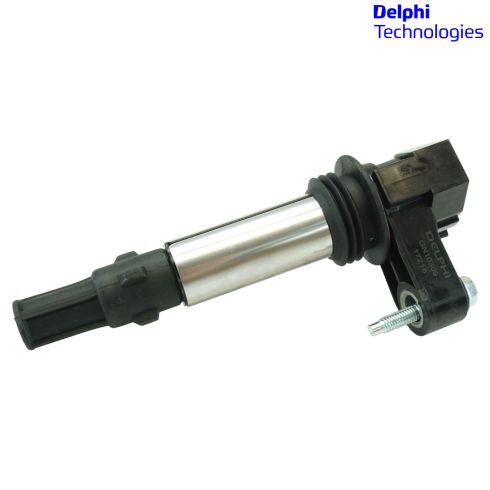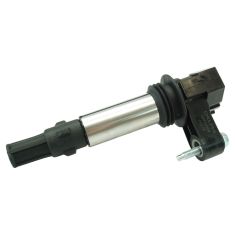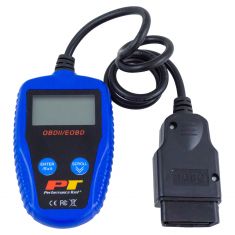Brought to you by 1AAuto.com, your source for quality replacement parts and the best service on the Internet.
Hi, I'm Mike from 1A Auto. I hope this how-to video helps you out, and next time you need parts for your vehicle, think of 1AAuto.com. Thanks.
In this video, we're going to be changing out the ignition coil on our 2006 Cadillac CTS 2.8-liter V6. If you like this information, please click the subscribe button. We have a ton more information on this vehicle as well as many other makes and models. If you want to buy these parts for your vehicle, they are available from 1AAuto.com. You can follow the link in the description.
Here are the items you'll need for this repair: 7mm, 10mm, 13mm, 15mm, 18mm socket, ratchet, and extension, 10mm wrench, flat blade screwdriver, rag, brake cleaner, torque wrench, painter’s tape
Remove the black caps over the nuts for the windshield wiper arms. All you have to do is squeeze them together, and pop them off. You're going to use a small piece of painters tape. Make sure you use the straight edge to mark the position and angle of the wiper blade, so we can reinstall our wiper arms properly.
Remove the two 15 millimeter nuts, securing the wiper arms down. The 15 millimeter socket and ratchet. If you're only replacing one arm, you'll only have to do this to that particular one. Work the wiper arms off of the splines. Do this by grabbing them at the joint. Simply pulling up and pushing down. Eventually, it'll work its way off the splines, and you can remove your wiper arm.
Peel off the leather strip. Remove these four 7 millimeter screws. We're going to use the 7 millimeter socket and ratchet. Lift up. Carefully release this plastic, as it's hooked under the windshield. You can see the little hooks right here. Just be careful to pull out and away with those.
Remove this 10 millimeter nut up against the fender on the driver’s side. Lift up and off of the splines for the wiper arms.
Remove the driver's side of the cowl cover. Remove these two 10 millimeter bolts, securing the wiper transmission and assembly into the vehicle. It's a little easier to access this top one from the other side of the hood. We're going to use the 10 millimeter socket, ratchet, and extension. Lift up and toward the center of the vehicle to release this tab. Flip over the assembly. Release the connector. Remove the assembly from your vehicle.
We're going to remove the engine cover. Remove the oil cap. Lift up and pop off the cover, and reinstall the oil cap to prevent any dirt and debris from falling in while we're working. Using a flat blade screwdriver, loosen the intake boot clamp. Pop this back off the throttle body. Remove the yellow safety on throttle body electrical connector.
Push down on the tab, and release it from the throttle body motor. On the bottom of this fitting is a little tab. You want to push that out with a flat blade screwdriver. Remove the fitting from the nipple. Remove these two vacuum fittings. Simply going to pop them out, carefully, pry them out with a screwdriver.
Using a flat blade screw driver, pry the wire loom up off of the intake. Remove the vacuum booster line from the side of the intake. Lift up this sound deadening material, and release these two connectors. Remove these four bolts with a 10 millimeter socket and ratchet. Once all the bolts have been removed, move the brackets they were securing off the side of the manifold and out of the way.
Using a 10 millimeter wrench, remove these three bolts. Loosen this 18 millimeter bolt at the bottom of the bracket. Crack the bolt loose with an 18 millimeter socket and ratchet. Remove these six 13 millimeter bolts with a 13 millimeter socket and ratchet. Using a flat blade screwdriver, release this harness retainer from the throttle body. Remove the intake manifold.
With the intake manifold off, we can easily access all of our coil packs. We're going to do this one here because it's the easiest to film. All of yours will come out the same way. We'll pull out on this safety tab at the end. You may need a small flat blade screwdriver to help. Once this is pulled out, you can remove our connector. Loosen the hold down bolt with a 10mm socket and ratchet. This is a captured type bolt, so it won't actually come out from the coil pack. Once it's unthreaded, lift up and remove the coil pack from the vehicle.
Here we have our old part that we removed from our vehicle and our new part from 1AAuto.com. As you can see, these parts are exactly the same. Four pin connector on the back, captured 10 millimeter bolt on the top. Same length of the boot to go down into the sparkplug tube. Same connector at the bottom.
Some common symptoms of a faulty ignition coil can be a loss of spark, creating misfires or rich conditions in the vehicle. If you've narrowed down that your ignition coil pack is responsible for your check engine light or rough running condition, this new part from 1A Auto is going to go in, direct fit just like your original equipment. Can fix you up right.
Install the ignition coil on to the plug until it clicks, tighten down the 10mm bolt, reinstall the connector, lock the slide back down into place.
Remove your old intake manifold upper plenum gaskets from the intake runners. We'll spray a little brake cleaner on a clean rag or paper towel. We'll wipe all the oil and debris off of the gasket surfaces, both on the plenums of the intake here and on the ports of the manifold itself. Just want to make sure those are nice and clean. Do the same thing here on the bottom side of the intake manifold itself. Wipe off that contact surface on the ports. If you feel any burs or debris build up file that off carefully.
You'll see that there's a small tab that sits into a hole on the top of the runners, as well as a hole that sits onto this dowel on your new intake gaskets. Go ahead and line all that up, and we'll install our intake manifold. Start your 13 millimeter bolts, once you have the manifold set onto its tabs. The longest ones will go into these four counter sunk holes in the center, and the shorter two will go on these outside ones. Tighten all these downs with the 13 millimeter socket and ratchet. Torque these bolts to 17 foot-pounds.
Reconnect the electrical connectors at the rear of the manifold, the brake booster vacuum line, and the two PCV lines; one of each side. Reconnect this fitting to the nipple at the front of the manifold, until that clicks into place. Reinstall the four 10 millimeter bolts for the harness hold downs. Three on the passenger side; one on the driver. You'll then tighten them down with a 10 millimeter socket and ratchet. Line up this bracket. Spin this 10 millimeter bolt in. Tighten up the bolt we loosened at the base of this bracket with an 18 millimeter socket and ratchet. Snug this bolt with a 10-millimeter wrench. Reinstall the sound deadening material onto its pends, as well as the throttle body connector. Lock that safety back into place.
Reinstall the air box on the end. Make sure this vacuum line at the back of that box is still connected. Tighten the clamp with a flat blade screwdriver. Remove the oil fill cap. Reinstall the engine cover. Reinstall your oil fill cap. Reconnect the electrical connector. Set this opening onto the pin. Start tightening down your two 10 millimeter bolts.
Reinstall the driver’s side of the cowl cover first. Be sure that all the plastic hooks line up under the windshield. Reinstall the 10 millimeter nut. Reinstall the passenger side of the cowl cover. Again, make sure all of these hooks line up, and go underneath the windshield.
Reinstall your 7 millimeter screws. Reinstall the rubber seal. The channel simply presses on to this ridge here. Line up your wiper to the tape mark we made on the windshield earlier. Torque to 26 foot-pounds. Line up your wiper to the tape mark we made earlier. Start the nut by hand. Torque the nut to 26 foot-pounds. Reinstall the plastic cap. Close the hood. Remove the tape marks from the windshield. Check for proper operation of your wiper motor.
Thanks for tuning in. We hope this video helped you out. Next time you need parts for your car, please visit 1AAuto.com. Also check out our other helpful how-to and diagnosis videos.















